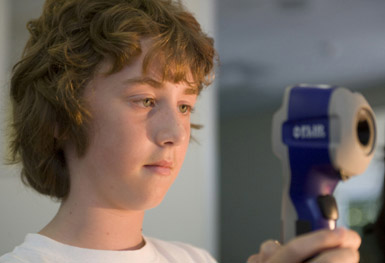We are developing a unique approach that uses affordable IR cameras (e.g., the $249 FLIR ONE) to visualize invisible energy flows and transformations in easy-to-do science experiments. Using this "desktop remote sensing" approach, thermal energy can be readily "seen." Other types of energy that convert into thermal energy can be inferred from thermal signals. Hence, many invisible physical, chemical, and biological processes that absorb or release heat can be visualized, discovered, and investigated.
Experiments
Water Percolation: Paper vs. Plastic
Water molecules can diffuse through paper, but not plastic.
Read more »
« Link to this

Which Colors Absorb More Light Energy?
Use your word processor to print a page with different color bars and put it under a table lamp.
The temperature difference between different colors reflects the difference in their abilities to absorb light energy.
Read more »
« Link to this

Which Colors Absorb More Sunlight?
Use your word processor to print a page with different color bars and put it under the sun.
The temperature difference between different colors reflects the difference in their abilities to absorb light energy.
Read more »
« Link to this

Which color of light gets absorbed more?
A prism was used to separate sunlight into light of different colors projected onto a screen made of black paper.
This video shows colors closer to the violet end got absorbed less.
(Because IR light from the sun cannot pass through the prism, IR absorption cannot be shown in this experiment.)
Read more »
« Link to this

Evaporative Cooling of a Half-Covered Container
Half of a plastic container was covered by a plastic film. The evaporation of water from the open half cooled down that part.
Read more »
« Link to this

Why is Water Temperature Independent of Water Amount in an Open Cup?
Three identical containers had different amounts of water. After a long time, the temperatures of water in them appeared to be
about the same. As they had identical surface area for evaporation, the evaporative cooling power
should be approximately the same. But shouldn't the water in a container that has less water be cooler?
Read more »
« Link to this

Obstructing Microconvection in a Cup of Water
Why does an entire cup of water become cooler than room temperature after a long time? We know there is evaporative cooling occurring at the surface of water,
but that cools down only the surface layer. The cooled surface water then sinks because of natural convection. This convection is so weak that we cannot see it at all,
which is why I call it "microconvection." But this microconvection still transfers heat faster than conduction.
Read more »
« Link to this

Why does Brine Warm Up Faster Than Ice?
Put a container of saturated saltwater and freshwater in the freezer for at least 10 hours so that they have the same temperature
(low enough to freeze freshwater but not saturated saltwater). Then take them out and let them warm up.
This video shows that the saltwater container warmed up much faster than the ice container.
The difference is due to the latent heat of ice.
Read more »
« Link to this

Adding Salt to Ice: Freezing Point Depression
Adding salt to ice not only melts the ice, but also results in significant cooling in so doing.
This is the reason why people add salt to ice to freeze the ice cream mixture when making ice cream.
Read more »
« Link to this

Adding Sugar and Salt to Ice
This video shows that adding sugar to ice hardly melts ice, compared with adding salt.
Read more »
« Link to this

